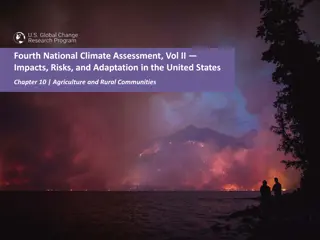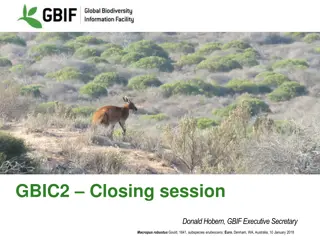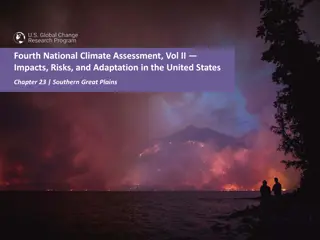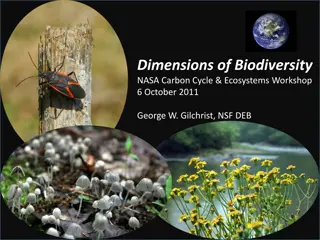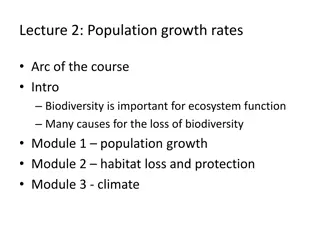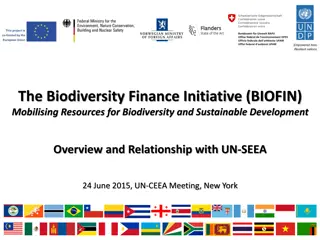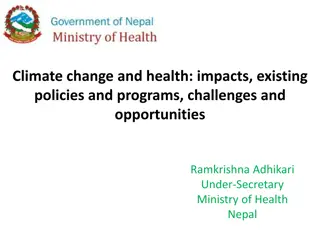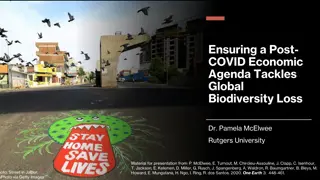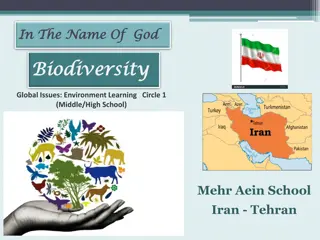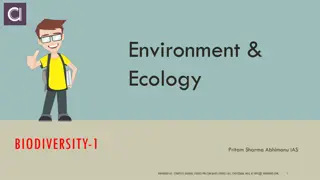Impacts of Climate Change on Ecosystems and Biodiversity in the United States
Climate change is significantly affecting species, populations, and ecosystems in the United States. Changes include alterations in the characteristics of organisms, shifts in biological event timing, and disruptions in geographic ranges. These impacts can lead to extinctions when species can't adapt. Ecosystem productivity is changing, invasive species are spreading, and interactions among species and with the environment are evolving. Ecosystem services vital for human livelihoods, food, water, and protection are at risk. Adaptive strategies are needed for natural resource management to address these challenges effectively.
Download Presentation

Please find below an Image/Link to download the presentation.
The content on the website is provided AS IS for your information and personal use only. It may not be sold, licensed, or shared on other websites without obtaining consent from the author. Download presentation by click this link. If you encounter any issues during the download, it is possible that the publisher has removed the file from their server.
E N D
Presentation Transcript
Fourth National Climate Assessment, Vol II Impacts, Risks, and Adaptation in the United States Chapter 7 | Ecosystems, Ecosystem Services, and Biodiversity Fourth National Climate Assessment, Vol II Impacts, Risks, and Adaptation in the United States nca2018.globalchange.gov 1
Ch. 7 | Ecosystems, Ecosystem Services, and Biodiversity Key Message #1 7 Impacts on Species and Populations Climate change continues to impact species and populations in significant and observable ways. Terrestrial, freshwater, and marine organisms are responding to climate change by altering individual characteristics, the timing of biological events, and their geographic ranges. Local and global extinctions may occur when climate change outpaces the capacity of species to adapt. Fourth National Climate Assessment, Vol II Impacts, Risks, and Adaptation in the United States nca2018.globalchange.gov 2
Ch. 7 | Ecosystems, Ecosystem Services, and Biodiversity Key Message #2 7 Impacts on Ecosystems Climate change is altering ecosystem productivity, exacerbating the spread of invasive species, and changing how species interact with each other and with their environment. These changes are reconfiguring ecosystems in unprecedented ways. Fourth National Climate Assessment, Vol II Impacts, Risks, and Adaptation in the United States nca2018.globalchange.gov 3
Ch. 7 | Ecosystems, Ecosystem Services, and Biodiversity Key Message #3 7 Ecosystem Services at Risk The resources and services that people depend on for their livelihoods, sustenance, protection, and well-being are jeopardized by the impacts of climate change on ecosystems. Fundamental changes in agricultural and fisheries production, the supply of clean water, protection from extreme events, and culturally valuable resources are occurring. Fourth National Climate Assessment, Vol II Impacts, Risks, and Adaptation in the United States nca2018.globalchange.gov 4
Ch. 7 | Ecosystems, Ecosystem Services, and Biodiversity Key Message #4 7 Challenges for Natural Resource Management Traditional natural resource management strategies are increasingly challenged by the impacts of climate change. Adaptation strategies that are flexible, consider interacting impacts of climate and other stressors, and are coordinated across landscape scales are progressing from theory to application. Significant challenges remain to comprehensively incorporate climate adaptation planning into mainstream natural resource management, as well as to evaluate the effectiveness of implemented actions. Fourth National Climate Assessment, Vol II Impacts, Risks, and Adaptation in the United States nca2018.globalchange.gov 5
Ch. 7 | Ecosystems, Ecosystem Services, and Biodiversity Climate change impacts on ecosystems reduce their ability to improve water quality and regulate water flows. Climate change, combined with other stressors, is overwhelming the capacity of ecosystems to buffer the impacts from extreme events like fires, floods, and storms. Landscapes and seascapes are changing rapidly, and species, including many iconic species, may disappear from regions where they have been prevalent or become extinct, altering some regions so much that their mix of plant and animal life will become almost unrecognizable. Timing of critical biological events, such as spring bud burst, emergence from overwintering, and the start of migrations, has shifted, leading to important impacts on species and habitats. Whole system management is often more effective than focusing on one species at a time, and can help reduce the harm to wildlife, natural assets, and human well-being that climate disruption might cause. Table 7.1: Key Messages from the Third National Climate Assessment Ecosystems, Biodiversity, and Ecosystem Services Chapter Key Findings from the Third National Climate Assessment Ecosystems, Biodiversity, and Ecosystem Services Chapter2 Fourth National Climate Assessment, Vol II Impacts, Risks, and Adaptation in the United States nca2018.globalchange.gov 6
Ch. 7 | Ecosystems, Ecosystem Services, and Biodiversity Fig. 7.1: Climate Change, Ecosystems, and Ecosystem Services Climate and non-climate stressors interact synergistically on biological diversity, ecosystems, and the services they provide for human well-being. The impact of these stressors can be reduced through the ability of organisms to adapt to changes in their environment, as well as through adaptive management of the resources upon which humans depend. Biodiversity, ecosystems, ecosystem services, and human well-being are interconnected: biodiversity underpins ecosystems, which in turn provide ecosystem services; these services contribute to human well-being. Ecosystem structure and function can also influence the biodiversity in a given area. The use of ecosystem services by humans, and therefore the well-being humans derive from these services, can have feedback effects on ecosystem services, ecosystems, and biodiversity. Sources: NOAA; USGS; DOI. Fourth National Climate Assessment, Vol II Impacts, Risks, and Adaptation in the United States nca2018.globalchange.gov 7
Ch. 7 | Ecosystems, Ecosystem Services, and Biodiversity Fig. 7.2: Genetic Diversity and Climate Exposure Genetic diversity is the fundamental basis of adaptive capacity. Throughout the Pacific Northwest, (a) bull trout genetic diversity is lowest in the same areas where (b) climate exposure is highest; in this case, climate exposure is a combination of maximum temperature and winter flood risk. Sub- regions within the broader Columbia River Basin (shaded gray) represent different watersheds used in the vulnerability analysis. Values are ranked by threat, such that the low genetic diversity and high climate exposure are both considered high threats (indicated as red in the color gradient). Source: adapted from Kovach et al. 2015.15 Fourth National Climate Assessment, Vol II Impacts, Risks, and Adaptation in the United States nca2018.globalchange.gov 8
Ch. 7 | Ecosystems, Ecosystem Services, and Biodiversity Fig. 7.3: Trends in First Leaf and First Bloom Dates These maps show observed changes in timing of the start of spring over the period 1981 2010, as represented by (top) an index of first leaf date (the average date when leaves first appear on three indicator plants) and (bottom) an index of first bloom date (the average date when blossoms first appear on three indicator plants). Reds and yellows indicate negative values (a trend toward earlier dates of first leaf or bloom); blues denote positive values (a trend toward later dates). Units are days per decade. Indices are derived from models driven by daily minimum and maximum temperature throughout the early portion of the growing season. Source: adapted from Ault et al. 2015.21 Fourth National Climate Assessment, Vol II Impacts, Risks, and Adaptation in the United States nca2018.globalchange.gov 9
Ch. 7 | Ecosystems, Ecosystem Services, and Biodiversity Fig. 7.4: Projected Range Expansion of Invasive Lionfish Lionfish, native to the Pacific Ocean, are an invasive species in the Atlantic. Their range is projected to expand closer to (a) the U.S. Atlantic coastline as a result of climate change. The maps show projected range expansion of the invasive lionfish in the southeast United States by mid-century (green) and end of the century (red), based on (b) the lower and (c) higher scenarios (RCP4.5 and RCP8.5, respectively), as compared to their recently observed range (blue). The projected range shifts under a higher scenario (RCP8.5) represents a 45% increase over the current year-round range. Venomous lionfish are opportunistic, generalist predators that consume a wide variety of invertebrates and fishes and may compete with native predatory fishes. Expansion of their range has the potential to increase the number of stings of divers and fishers. Source: adapted from Grieve et al. 2016.77 Fourth National Climate Assessment, Vol II Impacts, Risks, and Adaptation in the United States nca2018.globalchange.gov 10
Ch. 7 | Ecosystems, Ecosystem Services, and Biodiversity Fig. 7.5: Regional Ecosystems Impacts This figure shows selected examples of impacts to biodiversity, ecosystems, and ecosystem services that are linked to climate change throughout the United States. See the online version at https://nca2018.globalchange.go v/chapter/7#fig-7-5 for more examples. Fourth National Climate Assessment, Vol II Impacts, Risks, and Adaptation in the United States nca2018.globalchange.gov 11
Ch. 7 | Ecosystems, Ecosystem Services, and Biodiversity Fig. 7.6: Agricultural Productivity The figure shows the projected percent change in the yield of corn, wheat, soybeans, and cotton during the period 2080 2099. Units represent average percent change in yields under the higher scenario (RCP8.5) as compared to a scenario of no additional climate change. Warmer colors (negative percent change) indicate large projected declines in yields; cooler colors (green) indicate moderate projected increases in yields. Source: adapted from Hsiang et al. 2017.179Data were not available for the U.S. Caribbean, Alaska, or Hawai i and U.S.-Affiliated Pacific Islands regions. Fourth National Climate Assessment, Vol II Impacts, Risks, and Adaptation in the United States nca2018.globalchange.gov 12
Ch. 7 | Ecosystems, Ecosystem Services, and Biodiversity Chapter Author Team 7 Sarah Gaichas, National Oceanic and Atmospheric Administration Kimberly J. W. Hyde, National Oceanic and Atmospheric Administration Toni Lyn Morelli, U.S. Geological Survey Jeffrey Morisette, U.S. Department of the Interior, National Invasive Species Council Secretariat Hassan Moustahfid, National Oceanic and Atmospheric Administration Roldan Mu oz, National Oceanic and Atmospheric Administration Rajendra Poudel, National Oceanic and Atmospheric Administration Michelle D. Staudinger, U.S. Geological Survey Federal Coordinating Lead Authors Shawn Carter, U.S. Geological Survey Jay Peterson, National Oceanic and Atmospheric Administration Chapter Leads Douglas Lipton, National Oceanic and Atmospheric Administration Madeleine A. Rubenstein, U.S. Geological Survey Sarah R. Weiskopf, U.S. Geological Survey Chapter Authors Lisa Crozier, National Oceanic and Atmospheric Administration Michael Fogarty, National Oceanic and Atmospheric Administration Fourth National Climate Assessment, Vol II Impacts, Risks, and Adaptation in the United States nca2018.globalchange.gov 13
Ch. 7 | Ecosystems, Ecosystem Services, and Biodiversity Chapter Author Team 7 Chapter Authors (cont.) Charles Stock, National Oceanic and Atmospheric Administration Laura Thompson, U.S. Geological Survey Robin Waples, National Oceanic and Atmospheric Administration Jake F. Weltzin, U.S. Geological Survey Review Editor Gregg Marland, Appalachian State University Fourth National Climate Assessment, Vol II Impacts, Risks, and Adaptation in the United States nca2018.globalchange.gov 14
Ch. 7 | Ecosystems, Ecosystem Services, and Biodiversity Acknowledgments 7 USGCRP Coordinators Matthew Dzaugis, Program Coordinator Allyza Lustig, Program Coordinator Fourth National Climate Assessment, Vol II Impacts, Risks, and Adaptation in the United States nca2018.globalchange.gov 15
Recommended chapter citation Lipton, D., M.A. Rubenstein, S.R. Weiskopf, S. Carter, J. Peterson, L. Crozier, M. Fogarty, S. Gaichas, K.J.W. Hyde, T.L. Morelli, J. Morisette, H. Moustahfid, R. Mu oz, R. Poudel, M.D. Staudinger, C. Stock, L. Thompson, R. Waples, and J.F. Weltzin, 2018: Ecosystems, Ecosystem Services, and Biodiversity. In Impacts, Risks, and Adaptation in the United States: Fourth National Climate Assessment, Volume II [Reidmiller, D.R., C.W. Avery, D.R. Easterling, K.E. Kunkel, K.L.M. Lewis, T.K. Maycock, and B.C. Stewart (eds.)]. U.S. Global Change Research Program, Washington, DC, USA. doi: 10.7930/NCA4.2018.CH7 Read the full chapter https://nca2018.globalchange.gov/chapter/ecosystems nca2018.globalchange.gov Fourth National Climate Assessment, Vol II Impacts, Risks, and Adaptation in the United States nca2018.globalchange.gov 16








